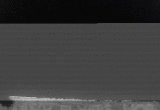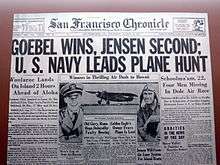Dole Air Race

.jpg)
The Dole Air Race, also known as the Dole Derby, was a tragic air race across the Pacific Ocean from northern California to the Territory of Hawaii in August 1927. Of the 15-18 airplanes entered, eleven were certified to compete but three crashed before the race, resulting in three deaths. Eight eventually participated in the race, with two crashing on takeoff and two going missing during the race. A third, forced to return for repairs, took off again to search for the missing and was itself never seen again. In all, before, during, and after the race, ten lives were lost and six airplanes were total losses. Two of the eight planes successfully landed in Hawaii.
The Dole prize

Inspired by Charles A. Lindbergh's successful trans-Atlantic flight, James D. Dole, the Hawaii pineapple magnate, put up a prize of US$25,000 for the first fixed-wing aircraft to fly the 3,870 kilometers (2,400 mi) from Oakland, California to Honolulu, Hawaii, and US$10,000 for second place.[1]
The transpacific record
The first transpacific flight had already taken place, twice over. On 28 June, about a month after Dole posted the prizes, Air Corps Lieutenants Lester J. Maitland and Albert F. Hegenberger flew a three-engine Atlantic-Fokker C-2 military aircraft from Oakland Municipal Airport to Wheeler Army Airfield on Oahu in 25 hours and 50 minutes. Ernie Smith and Captain C.H. Carter had arrived earlier for the attempt, but due to mechanical difficulties, took off two hours after Maitland, and returned with a broken windshield. Carter quit after the record was lost, but Smith hired Emory Bronte as a navigator, and the City of Oakland, a small Travel Air 5000 civilian monoplane, took off again on July 14.[2] Upon running out of fuel 26 hours and 36 minutes later, they crash-landed in a thorn tree on Molokai. Dole disqualified both of them from his prizes because they did not land in Honolulu (the Air Corps flight had been planned months prior to the prize announcement and had no intent to land other than at Wheeler).
The Dole Air Derby
.jpg)
An early entrant was Richard Grace, a Hollywood stunt pilot who shipped his plane to San Francisco shortly after wrecking his Cruzair in a Kauai to San Francisco attempt in June.[3] The draw for starting position in the Dole race was held on 8 August in the office of C. W. Saunders, California director of the National Aeronautics Association, in the Matson Building in San Francisco.
Two days after the draw, United States Navy Lieutenants George W. D. Covell and R. S. Waggener took off from San Diego, California in their Tremaine Humming Bird Spirit of John Rodgers to fly to Oakland, flew into a fog bank, crashed into an ocean cliff at Point Loma, and died.[4] The next day, British pilot Arthur V. Rogers took off for a test flight in the twin engine Angel of Los Angeles at Western Air Express Field at Montebello, California, circled, came about to land, jumping out of the plane before it suddenly dived into the ground, and died.[5]
Meanwhile, Mildred Doran, Auggy Pedlar, and navigator Manley Lawling were flying into Oakland when their aircraft developed engine trouble. They successfully landed in a wheat field in the San Joaquin Valley, but had trouble making repairs because they no longer had any tools. Doran was quoted as stating, "We threw [the tools] off at Long Beach because they were in the way and cluttering things up." Lawling was later replaced by Vilas R. Knope when Lawling could not satisfy the race committee of his navigational skills. He reportedly got lost over Oakland.
Then, on 11 August, as J. L. Giffin and Theodore S. Lundgren approached Oakland, their aircraft, an International CF-10 Triplane, the Pride of Los Angeles, crashed into San Francisco Bay, but the two men were unhurt.
In test flights before the race, Gobel's Woolaroc encountered gear issues that required Gobel to hang outside the plane to fix. The Air King (City of Peoria) flown by Charles Parkhurst Lomax and Ralph C. Lower Jr, was disqualified on the 16th because its 370-gallon tanks were estimated to give the plane a range 300 miles short by inspectors. A missing component on the Miss Doran compass sparked fears of vandalism the night before the flight.[6]
Participants
The race began on 16 August, by which time the starting line-up had diminished to eight aircraft:
- Pabco Flyer, a Breese-Wilde Monoplane, NX646, flown alone by Livingston Gilson Irving
- Woolaroc, One of two modified Travel Air 5000 aircraft, NX869, flown by Arthur C. Goebel and navigated by William V. Davis Jr.[7]
- Oklahoma, a Travel Air 5000 sister ship of Woolaroc, NX911, piloted by Bennett Griffin and navigated by Al Henley[7]
- Aloha, a Breese-Wilde 5 Monoplane, NX914, flown by Martin Jensen and navigated by Paul Schluter
- El Encanto, a Goddard Special metal monoplane, NX5074, flown by Norman A. Goddard and Kenneth C. Hawkins, which was heavily favored in the pre-race odds
- Golden Eagle, the prototype Lockheed Vega 1 monoplane, NX913, flown by Jack Frost and navigated by Gordon Scott
- Miss Doran, a Buhl CA-5 Air Sedan, NC2915, flown by Auggy Pedlar, navigated by Vilas R. Knope, and carrying Mildred Doran
- Dallas Spirit, a Swallow Monoplane, NX941, flown by William Portwood Erwin and navigated by Alvin Eichwaldt
Takeoff, race and aftermath
The fifteen competitors were seen off by a crowd estimated to include 75,000 to 100,000 persons. Weather was predicted to have a high fog on takeoff and showers along the route.
The initial takeoffs were plagued with trouble. Oklahoma took off first just before 11am. The crew would eventually abort the flight over San Francisco with an overheating engine.[7] She was followed by El Encanto, which failed to clear the runway before she swerved and crashed. Pabco Flyer lifted momentarily into the air, then crashed some 7000 feet from the runway. Their crews were not hurt. Golden Eagle took off smoothly and flew out of sight. Miss Doran succeeded in taking off but circled back and landed less than ten minutes later, its engine “sputtering like a Tin Lizzie.”[8] Then Dallas Spirit returned to Oakland with fabric ripping off the fuselage.[9] Aloha and Woolaroc took off uneventfully, and Miss Doran succeeded on her second attempt. Pabco Flyer also tried and crashed a second time.

Woolaroc flew a great-circle route, flying at 4,000 to 6,000 feet of altitude. The navigator Davis used sextants and smoke bombs to calculate course and wind drift. They were greeted in Hawaii and escorted by a Boeing PW-9 out of Wheeler Field. Goebel and Davis won the race in 26 hours, 17 minutes, earning them the US$25,000 first prize. Aloha arrived in 28 hours, 16 minutes, earning Jensen and Schluter the US$10,000 second prize. Out of his $10,000 winnings, pilot Jensen gave his navigator Schulter only $25.[10] Neither Golden Eagle nor Miss Doran was ever seen again.[11]
The search for the Golden Eagle and Miss Doran was aided by three submarines, USS R-8 , USS S-42 , and USS S-46 . After repairing Dallas Spirit, Erwin and Eichwaldt joined the search, leaving Oakland for Honolulu. Their last radio message was that they were in a spin.[12] Neither was seen again. In the days after the race, the disqualified owners of the Air King charged that race officials should have disqualified the Golden Eagle, because it also had only 350 gallons of fuel capacity when it took off.[13] In a bitter conclusion, the father of the sponsor of the race, Rev. Charles F. Dole, died on November 27, 1927.[14]
Goebel and Davis returned on a Matson liner to an impromptu parade in San Francisco where they doubted there would be any survivors of a sea ditching.[15] Woolaroc has survived and is on display at the Woolaroc Museum in Oklahoma, which started as a hangar to store and display the plane.[16]
The racers in detail

| Model name | Launch Position | Pilot, Navigator | Notes |
|---|---|---|---|
| Travel Air 5000 Oklahoma | 1 | Bennett Griffin and Al Henley | Blue with yellow wings |
| Goddard Special El Encanto | 2 | Norman A. Goddard and Kenneth C. Hawkins | Silver |
| Breese-Wilde Model 5 Pabco Pacific Flyer | 3 | Livingston Gilson Irving | Orange |
References
- ↑ "Dole Derby". Retrieved 23 August 2011.
- ↑ Plane and Pilot. July 1967. Missing or empty
|title=(help) - ↑ "GRACE TO FLY IN DOLE RACE. Hawaii-California Flier Who Crashed to Enter Competition". The New York Times. 7 July 1927. p. 4.
- ↑ "American airplanes: ti - ty". Aerofiles.com. 2009-05-02. Retrieved 2011-04-28.
- ↑ "THIRD DOLE FLIER KILLED IN CRASH AT LOS ANGELES: Accident to Capt. A. V. Rogers Makes Three Planes Wrecked Among Entrants. HIS WIFE SEES THE TRAGEDY Parachute Leap Apparently Failed After Plane Nose Dived at 150 Feet. NINE REMAIN IN THE RACE They Seem Thankful for Their Decision to Put Start Off Until Tuesday.". The New York Times. 12 August 1927.
- ↑ "DOLE PRIZE FLIERS GUARD THEIR AEROS AS TAKE-OFF NEARS: Missing Compass Causes Talk of Vandalism in Tense Camp. KING OF AIR UNABLE TO PASS FULL TESTS Eight Machines Qualify to Fly Over the Pacific at Noon Today. DOLE PRIZE AIRMEN GUARD THEIR PLANES". The Washington Post. 16 August 1927.
- 1 2 3 Ed Phillips (Spring 1985). "Woolarc!". AAHS Journal.
- ↑ Above & Beyond: Aunt Mildred By Richard A. Durose; Air & Space/Smithsonian; March 2011
- ↑ "THWARTED DOLE RACER PLANS FLIGHT TO TOKYO: Pilot of Dallas Spirit, Disabled by Wind, Repairs Plane for New Start West. WEATHER DICTATES MOVE". The Washington Post. 18 August 1927. p. 3.
- ↑ "Winner of $10,000 in Dole Race Gives Only $25 to His Navigator", Boston Daily Globe, August 25, 1927, p8
- ↑ "FLOWERS CAST ON SEA FOR LOST DOLE FLIERS: Steamer Halts in Pacific While Tribute Is Paid to Six Men and Young Woman.". The New York Times. 17 September 1927.
- ↑ "CALLS DOLE RACE "MISTAKE." Ernest Smith Fears That Erwin May Have Stripped Fuselage". The New York Times. 21 August 1927. p. 2.
- ↑ "RULES WAIVED FOR LOST DOLE PLANE, IS CHARGE: Golden Eagle Had Less Fuel Than Required, Airways System Declares. TELEGRAM TO M'CRACKEN". The Washington Post. 19 August 1927.
- ↑ "REV. CHARLES F. DOLE DIES.: Peace Advocate Was Father of Sponsor of Dole Air Race". The New York Times. 28 September 1927.
- ↑ "WINNERS OF DOLE RACE BACK, BOWED IN SORROW: Goebel Says He Entertains No Hope for Seven Who Did Not Finish". The Washington Post. 1 September 1927.
- ↑ Ranch delights children; The Joplin Globe, by John Hacker, MONDAY, JUNE 12, 2000
- ↑ The Evening News. 16 August 1927. Missing or empty
|title=(help)
External links
- Dole Air Race at Flickr Commons via San Diego Air and Space Museum
- Movie reel of the Dole Air Race
Further reading
- Conant, Jane Eshleman (October 10, 1955). "Death Dogged the Dolebirds: Pioneer Pacific Fliers Wrote Tragic Chapter in Air History". San Francisco Call-Bulletin. Retrieved September 12, 2010.
- Forden, Lesley, The Glory Gamblers, The Story of the Dole Race, 1971 p. 90.
- Gary W. Hyatt (October 2009). Winners' Viewpoints: The Great 1927 Dole Race. Oldairfield, LLC.
- "Arthur C. Goebel". Davis-Monthan Airfield Register Website. November 2009. Retrieved September 12, 2010.